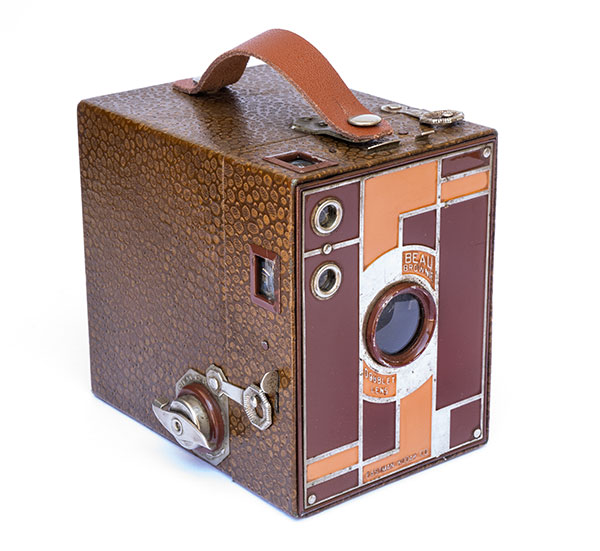
Another camera from the long series of Brownies. The first appeared in 1900, but this is the Beau Brownie model and was launched in October 1930. It remained in production for 3 years. Its hallmark is the art-deco design by Walter Dorwin Teague. It was manufactured in shades of black, blue, pink, green and brown. Teague was one of the first designers in the United States to assume that in addition to functionality, the aesthetics of a consumer product were something that people would value. It is interesting that before the Industrial Revolution, when furniture, clothing and household utensils were in the hands of artisans in laborious and expensive processes, production intended for aristocrats and wealthy bourgeoisie easily sacrificed functionality or ergonomics in favor of presenting an imposing aesthetic result.
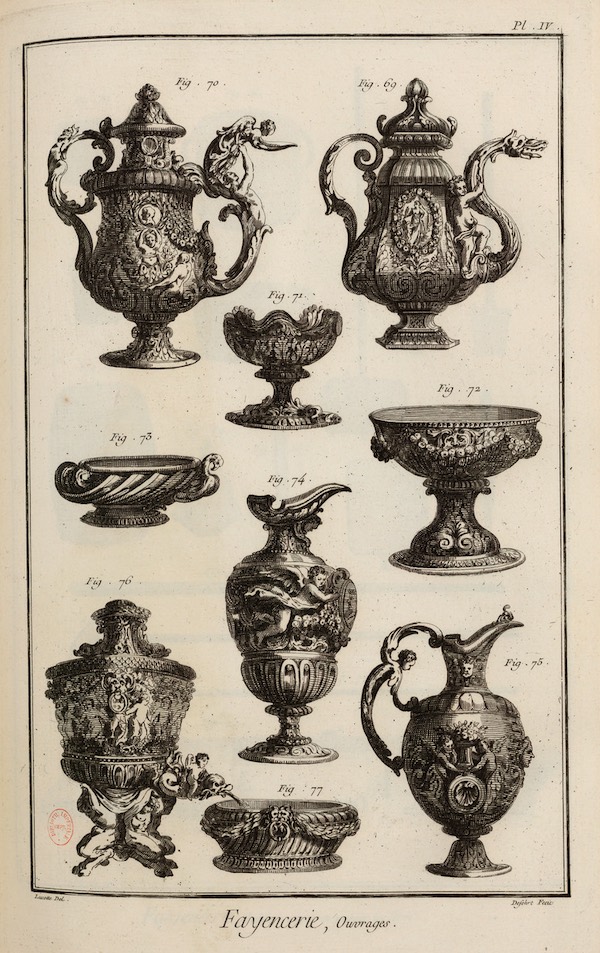
On this page of Diderot and D’Alambert’s Encyclopedia, from 1765, which illustrates faience pieces, we have examples that need no further explanation. But mainly from the beginning of the 20th century, the industry leaned towards an attractive design, according to the aesthetics of the moment, considering also production costs and usability. We can say that the first Kodak Brownie were more focused on the issue of cost and functionality. They were simple and very reliable cameras, but they were just boxes that at best offered a few color alternatives for the buyer to choose from. But in the 1930s, perhaps even as a result of the financial crisis that was shrinking the markets, Kodak decided to give its box cameras an extra appeal and thus, among others, nº2 Beau Brownie was born.
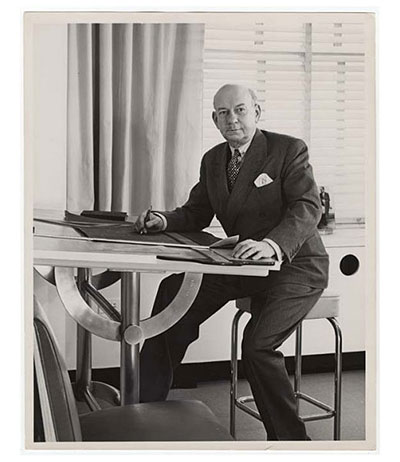
Walter Dorwin Teague
Walter Dorwin Teague was introduced to the Eastman Kodak Company by the then curator of The Metropolitan Museum of Art in New York and developed many designs for the company within an Art Deco style that is now highly prized by collectors. But the idea of producing cameras with an special aesthetic appeal would not have the success it had if Teague did not also know how to dialogue with engineers, analyze costs and reconcile his creative ideas with technical and market needs in the design of each camera. .
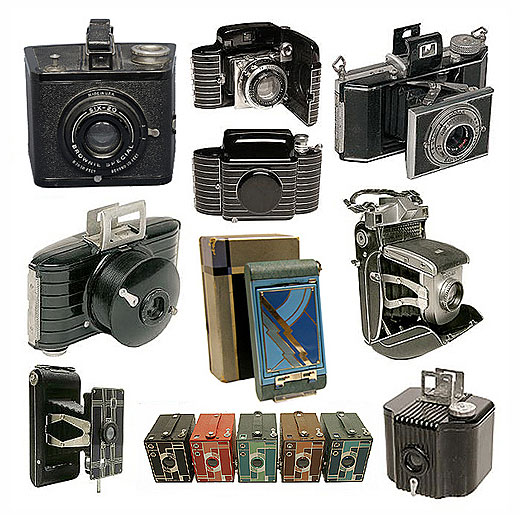
Above are designs he developed over the years of this collaboration. The Beau Brownie, which means Beautiful Brownie, as beau is beautiful in French, appear, in their available colors, in the center and bottom of the photo.
About the nº 2 Beau Brownie
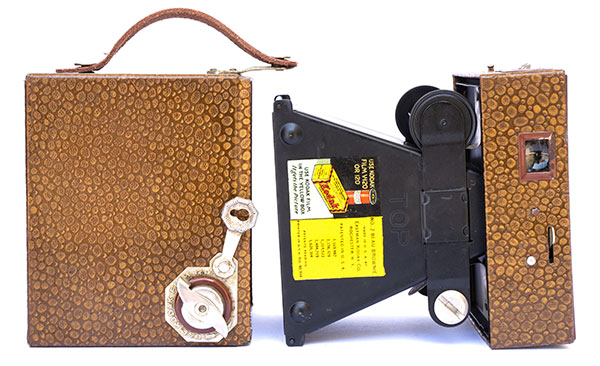
The camera uses roll film in a format coded as 120. I emphasize that this is just a code as I have seen many newcomers to analogue photography say “120 millimeters”, but this is not the case. The width of the film strip is 2¼” or 57mm, not 120 mm. Very convenient film type as it is still manufactured. Its longevity is impressive as it was released in 1901, along with the first Brownies, and is still produced today as it was adopted as standard film in medium format and equipped cameras such as Hasselblad, Pentax, Bronica, Ikonta, Bessa, Rolleiflex, Bronica and Mamiya, among others. The Beau Brownie negative measures 2¼ x 3¼”, or 57 x 82 mm, rounded. It is a size that allows prints by contact, that is, prints without the use of an enlarger, as they already allow a good visualization in something like the palm of the hand. Many old family albums are filled with photographs in this size or similar, such as the even more popular square format, 2¼ x 2¼”. Often these photos have a white margin and optionally the border is “pecked”.
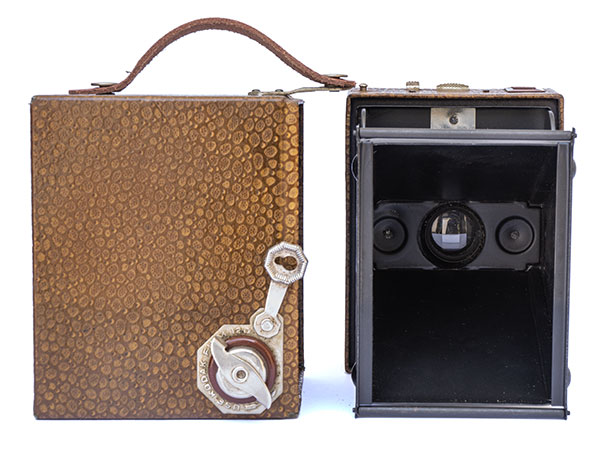
Because it has a rectangular frame and uses viewfinders for framing, two viewfinders are present to allow portrait and landscape orientations. They are very small, made up of two lenses and a 45º mirror. It is not very easy to see what you are framing depending on ambient light conditions. In general, we choose what will be in the center and we have an idea but not very precise control of what is framed in the corners. Another characteristic that is not very easy to deal with is that the image appears inverted right x left.
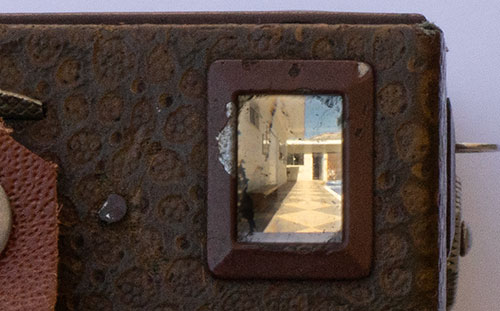
Viewfinder in portrait orientation
There is only one shutter speed, around 1/40s, or else you can use Bulb and the shutter stays open as long as you keep the shutter lever down. There is no cable release connector.

The lens is double, two menisci that appear symmetrical in relation to the diaphragm. But I didn’t find this documented to be sure. Measuring from the diaphragm to the film we have a focal length of ~100 mm. This gives a viewing angle of 45° on the long side, 32° on the short side of the image, and 53° diagonally. It is therefore a lens that we can call normal. However, I suppose that due to uncorrected aberrations the corners stretch the image and give the feeling that we have a more angular lens.
For aperture we have 3 options with a sliding diaphragm. I estimate that these apertures are f/11, f/16 and f/22, as the largest entrance pupil measures something like 9mm and I assume that the following diaphragms cut the exposure in half as is standard in photography. With modern films this means that outdoor pictures on a clear or even cloudy day are very easy without having to use “push development”. For a tripod, the camera has 1/4″ threads in landscape or portrait positions. But without a cable release, this is more difficult to use.
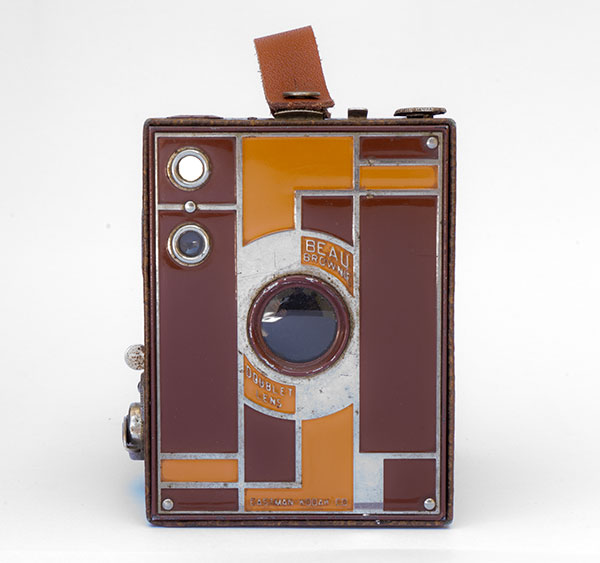
This example from the collection was purchased in Biévres in 2023, it came without the strap but, luckily, I had a piece of leather in the brown color matching the painting and so I was able to get a reasonable replacement. It came dusty inside. To open, just remove two little nails that are camouflaged by the painting on the sides of the front part of the camera. Removing them, the panel comes out in one piece. This gives full access to the front optical element and it is still possible to clean the rear while keeping the shutter open at B. The shutter is also exposed but the camera is all assembled with nails and rivets, I didn’t see any screws, this makes it very difficult to disassemble the mechanism if a more serious problem is occurring. Otherwise it is very simple like all Brownies.
Below are some photos I took with this camera. They are scans of prints on photographic paper in 13×18 cm, the first two, and 18×24 cm the last. The film was ISO 100. The fun thing about using a camera like this is that the challenge is finding a scene where it can do well. It is necessary to choose a clear day and a subject at least 3 meters away.

This photo was taken with f/22 and handheld camera. I cropped it a little to the right as the proximity plus the aberrations were spoiling the image a lot.

This photo surprised me by the backlight. When I did it I thought it would give a lot more glare. I needed to burn a little in the top left corner, but in my opinion it turned out a very acceptable print. I cropped a little at the bottom because I didn’t want to tilt the camera and with it horizontal there was a lot of ground. The aperture was f/16.
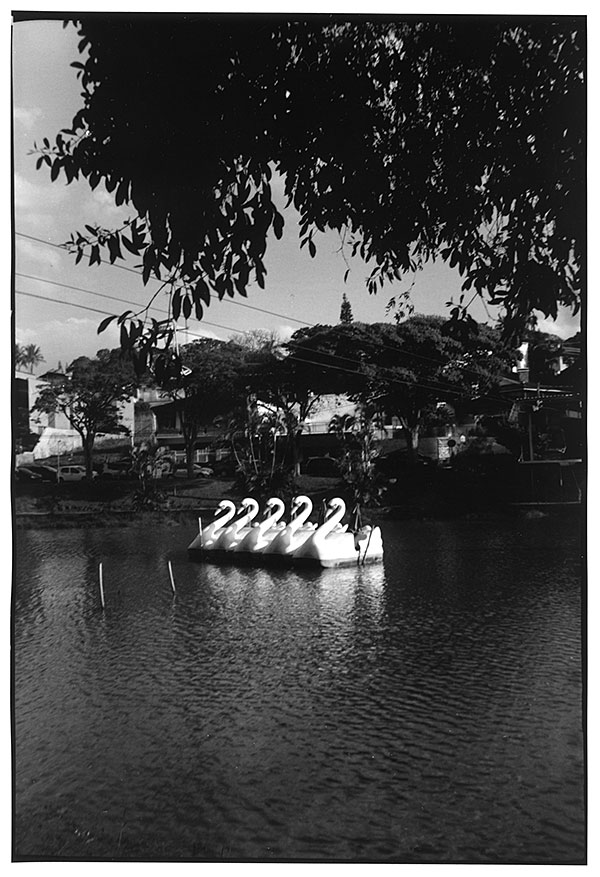
This is an entire negative and the aperture was f/22 handheld. I pass by this lake very often. I was hoping for a day when the sun would give more emphasis to the “swans”, leaving the rest more in the dark. They move in the lake, depending on the current. I was also hoping for a day when the light and their position would allow this half-profile view with all of them lined up. On the day I went to try out the Beau Brownie, the meteorological and celestial conditions were favorable and I was able to take this photo, which for me has a certain affective value because I have already taken delicious walks there.
Overall, I enjoyed using the Beau Brownie and plan on going out with it more often. It is always enjoyable using a vintage and so cute camera. Beyond that, the images it produces don’t disappoint if the subject x lighting conditions are favourable.
Bonjour,
Je découvre et j’apprécie beaucoup vos textes et avis.
Lors d’un déménagement familial, j’ai découvert cet appareil (Eastman Beau Brownie Doublet Lens) avec son étui et sa notice.
Il est dans un très bon état de conservation.
N’étant pas passionné de photo, comme vous pouvez l’être, je souhaite m’en séparer.
Seriez-vous intéressé ou sauriez vous m’informer de sa valeur ?
En vous remerciant de votre retour,
Bien cordialement
Ludovic
Salut Ludovic, je pense que le plus simple est de le mettre aux enchères en ligne. J’ai acheté le mien à une foire photo à Bièvres, près de Paris. Je l’ai payé 100 euros. Je crois que c’est à peu près tout. Comme le votre a encore son étui et sa notice, vous pouviez peut-être obtenir un prix encore plus élevé. Je vous souhaite bonne chance.